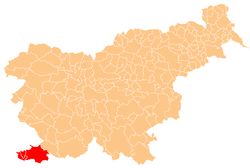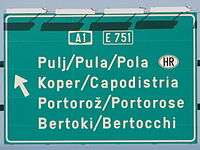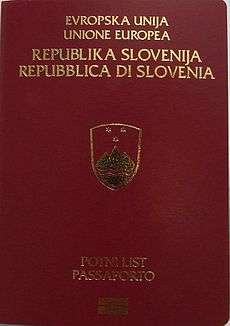Italian language in Slovenia

The Italian language is an officially recognized minority language in Slovenia, along with Hungarian. Around 3,700 Slovenian citizens speak Italian as their mother tongue. Italian has a strong presence in Slovenia, both historical and current. An estimated 15% of Slovenians speak Italian as a second language, which is one of the highest percentages in the European Union.[1]
History
Between the Late Middle Ages and 1797, part of the territory of the Slovenian Istria (almost entirely corresponding to the current municipalities of Koper, Izola and Piran) was under Venetian rule. During that period, the population of the coastal area, which had spoken various Romance dialects (either of Rhaeto-Romance or Istriot origin) adopted the Venetian dialect of Italian. During Austrian rule, which lasted until 1918, Italian was the official language of these areas, along with German. Only in the late 19th century, Slovene became co-official, but only in those rural areas where there was a Slovene ethnic majority.
According to the last Austrian census of 1910, of the around 75,000 inhabitants of Slovenian Istria, around 30,000 or 40% spoke Italian as their native language, while 60% spoke Slovene. Taken only the three municipalities of Koper, Izola in Piran (in their current border), the figures are 52% Italian speakers vs. 47% Slovene speakers. There was a big linguistic divide among the urban population and the rural areas: the towns were almost exclusively Italian speaking, while the rural areas had a large Slovene majority. Within the current borders of the municipality of Koper, 87% of the urban population was Italian speaking, while in its predominantly rural surroundings, they represented the 22,3% of the population. In Izola, Italian speakers amounted to 97% in the town, but only 12,8% in the surroundings. Only in the Piran municipality, they had a majority both in the urban and rural areas, with 95,9% and 64%, respectively.
After World War One, the entire Slovenian Littoral was annexed to Italy. During Fascism, a policy of Italianization was pursued, and all public use of Slovene was banished throughout the region. After World War Two, these areas were annexed to Socialist Yugoslavia, and the vast majority of the Italian-speaking population of the coastal town was either expelled by the Communist regime or decided to flee to Italy, in what became known as the Istrian Exodus. Only about a tenth of the Italian-speaking population remained. However, due to international and bilateral agreements that followed the dissolution of the Free Territory of Trieste, they were granted linguistic rights, and the entire territory of their traditional settlement became bilingual.
Geographic distribution and population
Italian is co-official with Slovene in three municipalities in the Slovenian portion of Istria: Piran (Italian: Pirano), Koper (Italian: Capodistria) and Izola (Italian: Isola d'Istria). The official census, carried out in 2002, reported 2,258 ethnic Italians in the country (0.11% of the total population). However, 3,762 people (0.2% of the total population and a slight dip from the number in the 1991 census) reported themselves to be mother tongue speakers of the language, of whom 1,832 declared themselves as being ethnic Italian, 1,195 as ethnic Slovenes, 34 as Croats, and 37 belonged to an ethnicity that was not listed.
Of the total 3,762 Italian native speakers in Slovenia, 2,853 live in one of the three municipalities where it is co-official: 1,174 in Piran, 1,059 in Koper, and 620 in Izola. Around 15% of all Slovenians speak Italian as a second language, which is the highest percentage in the European Union after Malta.[2] An estimated 5% of Slovenians use Italian in their daily life, which is the highest percentage in the European Union outside Italy.[3] The vast majority of those live in the Slovenian Littoral, where daily economic and personal contacts with neighboring Italy are common.

Usage of Italian
According to the Slovenian constitution, the Italian language is co-official in the areas of Slovenian Istria where the Italian people have been traditionally present as an autochthonous population. According to law, all official signs are to be written in both languages, as should all public notifications. Italian is to be used in all public offices in the bilingual area. Beside Slovene language schools, there are also elementary, high and grammar schools with Italian as the language of instruction. At the state-owned University of Primorska, however, which is also established in the bilingual area, Slovene is the only language of instruction (although the official name of the university includes the Italian version, too).
Italian can be used in the municipal assemblies of Koper, Izola and Piran, although in practice almost all discussions are carried out in Slovene.

See also
References
- Population by ethnic affiliation, Slovenia, Census 1953, 1961, 1971, 1981, 1991 and 2002
- Population by mother tongue, Slovenia, Census 1991 and 2002
- Population by mother tongue, municipalities, Slovenia, Census 2002